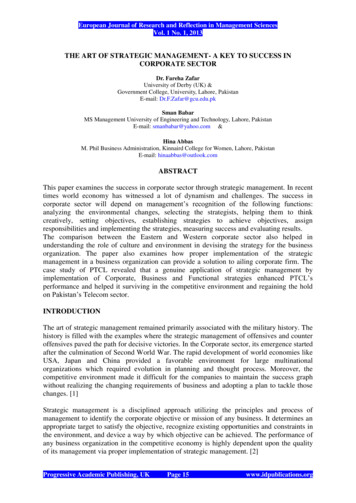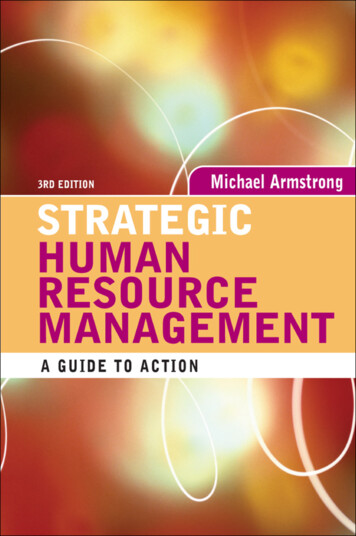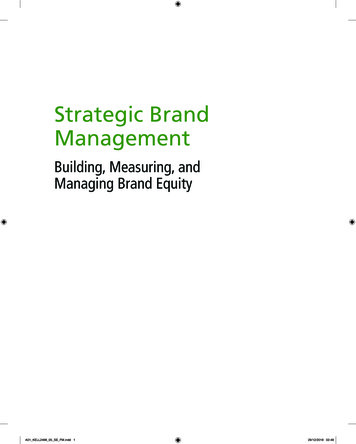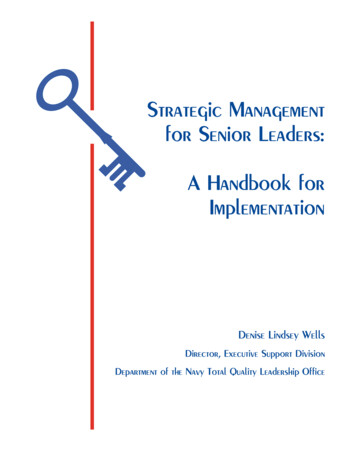
Transcription
European Journal of Research and Reflection in Management SciencesVol. 1 No. 1, 2013THE ART OF STRATEGIC MANAGEMENT- A KEY TO SUCCESS INCORPORATE SECTORDr. Fareha ZafarUniversity of Derby (UK) &Government College, University, Lahore, PakistanE-mail: Dr.F.Zafar@gcu.edu.pkSman BabarMS Management University of Engineering and Technology, Lahore, PakistanE-mail: smanbabar@yahoo.com &Hina AbbasM. Phil Business Administration, Kinnaird College for Women, Lahore, PakistanE-mail: hinaabbas@outlook.comABSTRACTThis paper examines the success in corporate sector through strategic management. In recenttimes world economy has witnessed a lot of dynamism and challenges. The success incorporate sector will depend on management’s recognition of the following functions:analyzing the environmental changes, selecting the strategists, helping them to thinkcreatively, setting objectives, establishing strategies to achieve objectives, assignresponsibilities and implementing the strategies, measuring success and evaluating results.The comparison between the Eastern and Western corporate sector also helped inunderstanding the role of culture and environment in devising the strategy for the businessorganization. The paper also examines how proper implementation of the strategicmanagement in a business organization can provide a solution to ailing corporate firm. Thecase study of PTCL revealed that a genuine application of strategic management byimplementation of Corporate, Business and Functional strategies enhanced PTCL’sperformance and helped it surviving in the competitive environment and regaining the holdon Pakistan’s Telecom sector.INTRODUCTIONThe art of strategic management remained primarily associated with the military history. Thehistory is filled with the examples where the strategic management of offensives and counteroffensives paved the path for decisive victories. In the Corporate sector, its emergence startedafter the culmination of Second World War. The rapid development of world economies likeUSA, Japan and China provided a favorable environment for large multinationalorganizations which required evolution in planning and thought process. Moreover, thecompetitive environment made it difficult for the companies to maintain the success graphwithout realizing the changing requirements of business and adopting a plan to tackle thosechanges. [1]Strategic management is a disciplined approach utilizing the principles and process ofmanagement to identify the corporate objective or mission of any business. It determines anappropriate target to satisfy the objective, recognize existing opportunities and constraints inthe environment, and device a way by which objective can be achieved. The performance ofany business organization in the competitive economy is highly dependent upon the qualityof its management via proper implementation of strategic management. [2]Progressive Academic Publishing, UKPage 15www.idpublications.org
European Journal of Research and Reflection in Management SciencesVol. 1 No. 1, 2013AIMThe aim of this research paper is to study about the Art of Strategic Management and its rolein the success of Corporate Sector.LITERATURE REVIEWStrategic management is the need of organization and also the ongoing debate in literature.Strategic management process is a tool that has been successfully used by the ailing corporateorganizations to prepare for the challenges of the future and improve their long termperformance. The organizations can improve the efficiency of the organizations and successof their plans through better analysis approaches and better dada collection of theorganization. As in the journal of business strategy, the Strategic management is defined as aprocess, during which an organization develops its strategies, that begins with missions andvisions made tangible as firm-wide goals and objectives. After specifying the firm direction,strategic management proceeds through strategic analysis and planning, formulation of plansthen implementation of the plans, and at last evaluation of past results. [3]The analysis of the environmental scanning is a major stage of strategic management process.The environmental research has direct impact on the formulation of strategies. The moreadverse the environmental conditions will be, the more innovative and dynamic strategieswould be required to cater for these challenges. All the environmental scanning models,developed over the years by business strategists, are of great help to the organization forcritically observing the changing dynamics of corporate sector. The comparison between theEastern and Western corporate sector also proved that the environmental and economicfactors have huge influence over the design of strategic management process. It has beenobserved from many experiences that China is in the early eras of western culture becausethere is absence of environmental consciousness, while Australian businesses are moreconcerned about the environmental changes.[4]The literature review also revealed that strategy formulation is a very important step and theailing corporate firm must hire the creative and brave strategists to make innovative and boldstrategies. These strategies are the theoretical remedial approach in solving the problemsfaced by the organization, but their effective implementation is the practical remedy of theproblems. Thus, the organizational excellence can only be achieved by both formulating aswell as implementing the right strategies.The test results verify that strategic planningperformance is also linked with the organization’s environmental turbulence, structure andfirm size.[5]The importance of all three Levels of strategic management has also been well established inthe literature. The different levels of strategies like corporate strategy, business strategy, andfunctional strategy take important part in enhancing firm performance. Corporate strategyincreases the organization’s capacity by improving the culture of the organization, then theinternal efficiency, then going toward customers and at last improving the financialperformance by increasing the company’s profitability, revenue, and decreasing the cost andrisk. The capacity of the transformation of the organization in response to economic changeshas also become critical success factor in the changing environment. In the competitiveenvironment the firms are continuously trying to change their strategies according to thesituation if the organization is unadaptive then it will fail to gain the competitive edge andalso lose the market share. In this ever-changing world the corporate also have to look onProgressive Academic Publishing, UKPage 16www.idpublications.org
European Journal of Research and Reflection in Management SciencesVol. 1 No. 1, 2013corporate governance, social responsibility and business ethics while making businessstrategies. [6]ELEMENTS OF STRATEGIC MANAGEMENTThe strategic management process does not get involved in the day to day running of theorganization’s operations, but instead creates the strategies for the accomplishment of Longterm objectives.There are four key elements to Strategic Management.a. Environmental Scanningb. Strategy Formulationc. Strategy Implementationd. Evaluation and ControlENVIRONMENTAL SCANNINGEnvironmental scanning is a process of evaluating the environmental factors at macro andmicro level in order to identify the organizational threats and opportunities.External Environmental ScanningExternal environmental scanning is very important for any organization. Sometimes, thesudden change in the corporate environment sector or an economic crisis may prove fatal foran organization. Over the years many models have been evolved for analyzing the externalenvironment.SLEPT Analysis- Social, Legal, Economic, Political and Technologicalanalysis.PESTEL Analysis - Political, Economic, Social, Technological, Environmental and Legalfactors.INTERNAL ENVIORNMENTAL SCANNINGUnderstanding own capabilities and weaknesses are as important as scanning the externalenvironment. Following model is often used for studying the internal as well as externalenvironmental factors.SWOT Analysis-Strengths, Weaknesses, Opportunities and Threat analysis. [7]Strategy FormulationStrategy formulation is the process with which the best course of action, for achieving theorganizational goals and objectives is decided. This process consists of three steps.(a) Generation of option(b) Evaluation of option(c) Selection of strategyProgressive Academic Publishing, UKPage 17www.idpublications.org
European Journal of Research and Reflection in Management SciencesVol. 1 No. 1, 2013Generation of optionsAfter analyzing the environmental conditions; the next stage in the strategic managementmodel is to generate options for choice.These options must be in line with the organization’sstated objectives and values. At this stage creativity is important, the strategist must look forout of the box option, and eventhe foolish looking ideas may be amended and become viableoptions.Evaluation of optionsAfter generating options; these must then be evaluated. This process needs to include; likelysuccess, cost affects, risk factors, time factors. After analyzing these factors the strategist candecide upon the most preferred option.Selection of strategyOnce all options are evaluated then the most preferred option needs to be selected. Before itcan be implemented; it needs to be presented to the Board of Directors for their approval. ION,VISION, GOALSSTRATEGICCHOICESEVALUATIONOF STRATEGY IMPLEMENTATIONStrategy implementation implies makingthe strategy work as intended or putting theorganization’s chosen strategy into action. Strategy implementation includes designingthe organization’s structure, distributing resources, developing decision making process, andmanaging human resources.EVALUATION AND CONTROLStrategy evaluation is the final step of strategy management process. The key strategyevaluation activities are: studying the effect of internal and external factors on presentstrategies, measuring performance, and taking remedial / corrective steps. Evaluation ensuresthat the organizational strategy as well as its implementation meets the organizationalobjectives.LEVELS OF STRATEGIC PLANNINGIn order to facilitate the strategic management process, the strategies are formulated andimplemented in three levels of strategic planning. These hierarchical levels help theorganizations in achieving both the annual objectives as well as long term objectives.Progressive Academic Publishing, UKPage 18www.idpublications.org
European Journal of Research and Reflection in Management SciencesVol. 1 No. 1, 2013CORPORATE STRATEGYIt is the highest level of strategy making in an organization. It is concerned about the overalldevelopment of the businesses within the organization. These strategies provide a directionfor a firm that what type of business it should be investing in. Corporate strategy is based onknowing: Where your organization is today.Where you want it to be.How you want to get there.The nature of strategic decisions tends to be value-oriented, conceptual and less concrete thandecisions at the business or functional level. [9]BUSINESS STRATEGYBusiness strategies are applicable to those firms which have different businesses and eachbusiness requires separate strategy. Although these strategies may differ from each other butall the business strategies of an organization or firm remain under the umbrella of the overallmission, vision and goals of the organization. The aim of this strategy is to gain competitiveadvantage in specific markets.FUNCTIONAL STRATEGYFunctional strategy is the implementation of corporate and business strategies. Thesestrategies are the means or the steps taken in order to effectively implement the higher levelof strategies. It deals with relatively restricted plan providing objectives for specific function.Functional strategies can either be non-quantifiable actions such as customer satisfaction orcan also be quantifiable actions such as number of orders placed or delivered in one day.A STRONG STRATEGIC MANAGEMENT – A SOLUTION TO AILINGCORPORATE FIRMSuccessful strategic management is led by innovative and futuristic strategists; who put theirpersonal imprint on the whole process and people management. This revolutionary approachcan prove as a solution to ailing corporate firms. The strategists have to start dealing theproblem in a systematic manner, which means creating a corporate level strategy thenaligning the business and functional level strategies to the mission and vision statements.CASE STUDY – PAKISTAN TELE COMMUNICATION LIMITED (PTCL)PTCL is the major phone company in Pakistan. It operates about 4.4 million fixed lines andhas a cellular arm Ufone that has a second largest share of the cell phone market in Pakistan.It had a monopoly on all phone services, but since the beginning of 21st century theintroduction of cellular networks created a huge competitive environment for PTCL. [10]Progressive Academic Publishing, UKPage 19www.idpublications.org
European Journal of Research and Reflection in Management SciencesVol. 1 No. 1, 2013Telecom RevenuesThe graph shows that introduction of cellular network has resulted in decline of revenuethrough local loop network. This result dictates a need of more dynamic corporate strategy inorder to cover up this revenue loss.Annual Fixed Local Line SubscribersThe graph shows a decrease in the number of fixed local line subscribers annually.This result shows the saturation in this business and asks for innovative businessstrategies by stepping into fields like cellular network and wireless local loopnetwork.CORPORATE STRATEGYIn 2005 privatization of PTCL was carried out. In this strategic shift 26% of the company’sshares were sold to the UAE based company “Etisalat” alongwith the management rights.This privatization brought a new life in the company and revolutionized its approach towardsthe emerging challenges. The new administration modernized the company’s vision andmission; and ensured quality customer service. [11]Progressive Academic Publishing, UKPage 20www.idpublications.org
European Journal of Research and Reflection in Management SciencesVol. 1 No. 1, 2013BUSINESS STRATEGYWireless Local LoopPTCL’s WLL segment has shown immense amount of growth. Although thegrowth rate is slower than expected, but even then this strategy proved to be an effectivereplacement of the Fixed Local Line service. In this field, PTCL has been facing toughcompetition from World call and Wateen. However with vast network presence andinfrastructural facilities across Pakistan, PTCL managed to outrun its competitors in thissegment.Annual Wireless Local Loop SubscribersThe graph shows a slow rate of increase in the number of annual subscribers of PTCL in thissegment. Although the rate of increase in Wateen is quite fast than PTCL but there is a hugedifference between the numbers of subscribers of both companies.Broadband and Value added servicesIntroduction of DSL Broadband services across major cities enhanced the revenue base ofPTCL. Although Stiff competition from other cable based broadband service providers andlocal cable operators still persists but due to its large network PTCL has gained competitiveadvantage in this segmentAnnual DSL Broadband SubscribersProgressive Academic Publishing, UKPage 21www.idpublications.org
European Journal of Research and Reflection in Management SciencesVol. 1 No. 1, 2013The graph shows the immense increase in the annual number of DSL subscribers from 2007to 2011. These statistics are a proof of successful business strategy in this segment.FUNCTIONAL STRATEGYHR DevelopmentOne of the most important objectives of this new strategy was to optimize the workforcewhich was implemented by offering the voluntary option of retirement from PTCL inexchange for financial compensation. Around 29,920employees opted for this option. Thisstrategy opened the doors of PTCL for energetic, motivated and creative employees whohelped in improving the image of the organization and added into the customer satisfactionlevel. [12]A COMPARISION BETWEEN STRATEGIC MANAGEMENT OF EASTERN ANDWESTERN CORPORATE SECTORThe requirement of Strategic management process for every firm is different. The corporateculture of the organization, economic factors and labor force statistics dictates the model ofstrategic management process required. The strategic management process for theorganizations of Eastern and Western corporate sectors differs in following aspects; [13]EASTERNWESTERNSequential strategic changes possibleEqual importance to both short-termand long term financial objectivesSome powers with the CEO aredevolved to managerial levelTop-down, bottom-up and lateraldecision making,Manyhierarchical layerBehavior oriented strategiesPeople oriented approachConsumer relations are both marketingand product drivenSubjective EvaluationRadical strategy changes possibleHigh importance of short-term financialobjectives in order to increase shareholder valueHigh concentration of power with the CEOClear top-down decision makingFlat hierarchiesResult oriented strategiesJob oriented approachConsumer relations are marketing drivenObjective EvaluationRECOMMENDATIONSStrategic management is not an easy, step by step process. It is not linear, but a messy,interactive process that requires hard work and dedication from most people in theorganization to move it towards the future. It represents a new focus for the organization; afocus on a compelling vision of the future. These recommendations can be helpful toorganizations in order to design an efficient strategic management process.KNOW YOUR MISSION, VISION AND GOALSDuring the strategic management process, it is important to remain aligned to theorganization’s mission, vision and goals. They make a foundation of any organization. TheirProgressive Academic Publishing, UKPage 22www.idpublications.org
European Journal of Research and Reflection in Management SciencesVol. 1 No. 1, 2013proper understanding helps the strategists in planning the strategic management process. Anystep not taken in accordance with the company’s mission statement will not only defame thecompany’s reputation but will also demoralize the workers.INNOVATIVE STRATEGISTS AS LEADERSIt is the responsibility of senior leadership to strategically manage the organization. Strategicmanagement is a continuous process rather than onetime event. Therefore, the senior leadersmust become strategic thinkers and leaders of the organization and its culture. To be mostsuccessful, leaders need to be facilitators, coaches, consultants and consensus builders.Acquiring these leadership traits require hard work and dedication, willingness to take somerisk, and internalizing organization’s vision and guiding principles.PRE PLANNING ACTIVITIESThe organization’s strategic management team must start its work by conducting the preplanning activities to prepare for strategic planning. It outlines a process whereby the seniorleaders of an organization can envision its future and begin to develop the necessaryprocedures and operations to achieve that future through goals, strategies, and objectives.After the completion of the pre-planning activities, the senior leadership team can begin thestrategic planning process. An initial strategic planning workshop can help in carrying outthese pre planning activities.DEVELOPING THE PLANA deliberate strategic plan must be made in accordance with the company’s vision andmission statement. A successful plan must consist of; Assign roles and responsibilities.Establish priorities.Involve mid-level management as active participants.Decide how to manage implementation.Charge mid-level management with aligning lower-level plans.Make careful choices about the contents of the plan and form it will take.COMMUNICATING THE PLANIn the absence of information and clear communication, rumors start flying, and people at thefunctional strategy level start assuming the worst. Most of the times, the strategies are justcommunicated to the top executives and the entire team is not taken into confidence. Thisleads to a serious mistrust and confusion among the team members and affect their efficiencyin solving the problems. Thus while formulating any strategy; strategists at all three levelsmust communicate the broad outlines of their strategy to the people who are going to executethe plan.WINNING THE COMMITMENT OF THE PEOPLEThe work force is the base of any organization and the new success factors create a sizzleamong them. The CEO and his management must take the work force in confidence. He mustexplain them how the new strategic management process can bring the profits back to theProgressive Academic Publishing, UKPage 23www.idpublications.org
European Journal of Research and Reflection in Management SciencesVol. 1 No. 1, 2013organization and benefit the work force. Winning their confidence and commitment can getall the key players in the organization on board and a collective effort towards the transitionof a company from failure to success can be guaranteed. [14]CONCLUSIONEvery organization handles its strategic management effort differently. Leadership style,maturity of the organization, structure and morale; all of these factors influence how anorganization will approach its strategic management efforts. But the most important thing inany process is the implementation of the strategy and its continuous evaluation. These factorshelp in gauging the practicality of a plan and ensure the company’s success and progress.“The best plan is only a plan, that is, good intentions, unless it degeneratesinto work. The distinction that marks a plan capable of producing results is thecommitment of key people to work on specific tasks. The test of a plan iswhether management actually commits resources to actions which willproduce results in the future. Unless such a commitment is made, there areonly promises and hopes, but no plan.”(Peter Drucker, 1986)REFRENCES[1]Hill, Charles W.L., and Gareth R, Jones. Strategic Management - An Integrated Approach.10th ed. N.p.: Erin Joyner, n.d. Print.[2]Dess, Gregory G., G.T. Lumpkin and Marilyn L. Taylor. Strategic Management. 2 ed.New York: McGraw-Hill Irwin, 2005[3] Tim Blumentritt, Tim. "Integrating Strategic Management and Budgeting." JOURNALOF BUSINESS STRATEGY 27 (2006): n. pag. Emerald Group Publishing Limited.Web.[4]Moore, Sharon, and Julie Jie Wen. "Strategic Management in Australia and China: TheGreat Leap Forward or an Illusion?" Journal of Technology Management in China(2007): n. pag. Emerald Group Publishing Limited. Web.[5] James Whelan, James D. Sisson, (1993) "How to Realize the Promise of StrategicPlanning", Journal of Business Strategy, Vol. 14 Iss: 1, pp.31 – 36.[6] Bertoncelj, Andrej, and DarkoKovacˇ. "Success Factors and Competencies inOrganisational Evolution." (2009): n. pag. Emerald. Emerald Group.[7] Jeffs, Chris. StrategicManagement. London ECISY ISP: SAGE Publication, 2008. Print.[8] Wright, Lindsay. "UNDERSTANDING STRATEGIC MANAGEMENT."N.p., n.d. Web.[9] Jhonson, Gerry, and Kevan Scholes. Exploring Corporate Strategy- Text and Cases. 8thed. N.p.: Financial Times, 2008. Print.[10]"Telecom Indicators." PTA. N.p., n.d. Web.[11] Jamal, Muhammad Anwar, Haroon Ur Rashid, Hussain Ullah, and Sheraz Ahmed."Impact of Privatization."Diss. Blekinge Institute of Technology School ofManagement, 2009.[12] Munir, Sana, and Midhat Batool. "PTCL Company Analysis."Scribd.PinkAlert, n.d.Web. 08 Dec. 2013.[13] Pudelko, Markus, and Anne Wil Harzing. "How European Is Management in Europe?"European Journal of International Management (January 2007): n. pag.[14]Wells,Denise Lindsey. Strategic Management for Senior Leaders: A Handbook for Implementation.N.p.: Department of the Navy Total Quality Leadership Office Publication No. 94-02,n.d. Print.Progressive Academic Publishing, UKPage 24www.idpublications.org
The art of strategic management remained primarily associated with the military history. The history is filled with the examples where the strategic management of offensives and counter offensives paved the path for decisive victories. In the Corporate sector, its emergence started af











